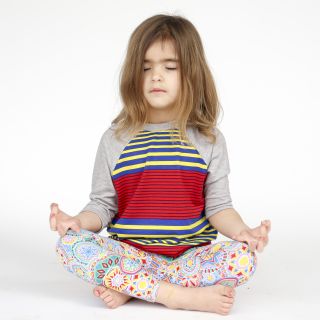Stress
A Quick Way to Help Your Child Master Stress
Progressive muscle relaxation is a proven technique and easy for kids to learn.
Posted April 11, 2023 Reviewed by Vanessa Lancaster
Key points
- Progressive muscle relaxation (PMR) is a form of physical relaxation that can lead to mental relaxation.
- PMR has been shown to help manage stress and anxiety and can help those who experience difficulties with sleep, headaches, or chronic pain.
- Parents can facilitate PMR by following steps that bring a child's awareness to a body part and relaxing it, and continuing throughout the body.

Co-authored by Ellie Xu and Darby Saxbe
Do you ever notice that your child seems stressed or worried at the end of a school day? Or does your child experience difficulties with sleep or chronic pain? If so, progressive muscle relaxation (PMR) could be a helpful technique to try out with your child!
PMR was first established as an effective relaxation technique by an American physician, Edmund Jacobson, who proposed that physical relaxation can lead to mental relaxation. PMR has been shown to help manage stress and anxiety and can be particularly helpful for those who experience difficulties with sleep, headaches, or chronic pain. In fact, PMR has even been shown to decrease the secretion of stress hormones, such as cortisol.
How can you help your child practice PMR? Below is a step-by-step guide, which you can walk through with your child, adapted from this script:
1. Have your child get into a comfortable position, seated or lying down. If they’d like, they can gently close their eyes.
2. Have them focus on their breathing. Ask them to take a deep breath in and notice their lungs and chest filling with air.
- Have them hold their breath for a few seconds and then exhale fully and completely.
- Have them take a few more deep breaths, in and out.
3. Have them bring their awareness to their hands. Ask them to act as if they are squeezing a lemon – they should squeeze their fists tightly, trying to squeeze all the juice out of the lemon. Then they should imagine squeezing the lemon for at least a few seconds.
- Now, have them imagine letting the lemon go and relaxing their fists. Have them notice the difference between the feeling of squeezing the lemon and letting the lemon go.
- Have them repeat this several times – squeezing the lemon and then letting it go.

4. Next, have them bring their awareness to their arms. Then they can imagine that they are a fluffy cat. Have them stretch their arms high above their head. Have them notice the pull in their arms and shoulders. Have them continue stretching their arms high above their head for at least a few seconds.
- Then, have them relax their arms by their side. Have them notice the difference between the feeling of stretching their arms and relaxing them.
- Have them repeat this several times – stretching their arms and then relaxing them.
5. Now, have them bring their awareness to their shoulders. Then imagine that they are a turtle, pulling their head under their shell. Ask them to press their shoulders up to their ears and push their head down into their shoulders. Do this for at least a few seconds.
- Then, have them raise their head back outside of their shell. Ask them to notice the difference between the feeling of pulling their head under their shell and raising their head out of it.
- Repeat this several times – pulling their head under their shell and then raising their head back out of it.
6. Next, have them bring their awareness to their jaw. Have them imagine a big bubble-gum-jawbreaker in their mouth. Tell them to imagine biting down on it hard. Hold that bite for at least a few seconds.
- Then, have them relax their jaw. Do they notice the difference between the feeling of biting down and relaxing their jaw?
- Repeat this several times – biting down and then relaxing their jaw.
7. Now, have them bring their awareness to their face and nose. Have them imagine a fly landing on their nose. Have them imagine scrunching up their face to try and get the fly off their nose. Have them scrunch up their face for at least a few seconds.
- Then, have them imagine that the fly has flown away, and have them relax their nose. Have them notice the difference between the feeling of scrunching up their nose and relaxing their nose.
- Have them repeat this several times – scrunching up their face to get rid of the fly and then relaxing their nose once it has flown away.
8. Next, have them bring their awareness to their stomach. Have them imagine a baby elephant about to step on their stomach. Have them tighten their stomach to make their stomach very hard. Have them continue tightening their stomach for at least a few seconds.
- Then, have them imagine the baby elephant has gone, and have them relax their stomach. Have them notice the difference between the feeling of tightening their stomach and relaxing their stomach.
- Have them repeat this several times – tightening their stomach and then relaxing it.
9. Now, have them bring their awareness to their legs and feet. Have them imagine that they are in a big puddle, standing barefoot. Have them try to push their feet down into the bottom of the puddle. Have them continue pushing their feet down for at least a few seconds.
- Then, have them imagine stepping out of the puddle, relaxing their feet. Have them notice the difference between the feeling of pushing down with their feet and relaxing their feet.
- Have them repeat this several times – pushing down with their feet and then relaxing their feet.
10. Now, have them sit comfortably for a moment. Have them scan their body for any lingering tension and have them release it. Have them notice how their body feels when it’s completely relaxed.
11. Have them open their eyes if they closed their eyes at the beginning of this exercise. Talk to your child about how their body and mind feel. Talk to them about the differences between how they feel now and when they began this exercise.
Practicing PMR once for 20 minutes can lead to short-term benefits in reducing stress. So, practicing PMR regularly for 20 minutes every day may provide even longer-term benefits. Guided PMR exercises, such as this one, can be found on popular platforms, such as YouTube, and can be incorporated into your child’s morning or evening routine to help them manage stress and anxiety.
Note: If your child experiences pain while practicing PMR, please consult their healthcare provider before proceeding.
References
Baird, C. L., & Sands, L. (2004). A pilot study of the effectiveness of guided imagery with progressive muscle relaxation to reduce chronic pain and mobility difficulties of osteoarthritis. Pain Management Nursing, 5(3), 97-104.
Carlson, C. R., & Hoyle, R. H. (1993). Efficacy of abbreviated progressive muscle relaxation training: A quantitative review of behavioral medicine research. Journal of Consulting and Clinical Psychology, 61(6), 1059–
1067. https://doi.org/10.1037/0022-006X.61.6.1059
Chellew, K., Evans, P., Fornes-Vives, J., Perez, G., & Garcia-Banda, G. (2015). The effect of progressive muscle relaxation on daily cortisol secretion. Stress, 18(5), 538-544. Dolbier, C. L., & Rush, T. E. (2012). Efficacy of abbreviated progressive muscle relaxation in a high-stress college sample. International Journal of Stress Management, 19(1), 48–68. https://doi.org/10.1037/a0027326
Liu, K., Chen, Y., Wu, D., Lin, R., Wang, Z., & Pan, L. (2020). Effects of progressive muscle relaxation on anxiety and sleep quality in patients with COVID-19. Complementary therapies in clinical practice, 39, 101132.
Meyer, B., Keller, A., Wöhlbier, HG. et al. Progressive muscle relaxation reduces migraine frequency and normalizes amplitudes of contingent negative variation (CNV). J Headache Pain 17, 37 (2016). https://doi.org/10.1186/s10194-016-0630-0
Murtadho, M. A., Herawati, L., & Arifin, H. (2019). The comparison of progressive muscle relaxation frequency on anxiety, blood pressure, and pulse of haemodialysis patients. Jurnal Ners, 14(1), 69-74.




